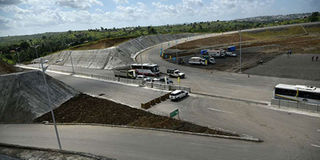Kenya pegs its growth on development of roads and ports

A section of the first phase of Dongo Kundu Bypass, in Mombasa, that was launched by President Uhuru Kenyatta on June 14, 2018. The infrastructure is expected to boost trade. PHOTO FILE | NATION MEDIA GROUP
What you need to know:
- The project will improve port’s cargo-handling capacity to serve Kenya’s growing economy
- The special economic zone will be developed in three phases, with the first expected to be ready by 2023
The government is banking on infrastructure projects in the coastal region to provide jobs and boost regional trade.
The Ministry of Transport sees the construction of Dongo Kundu bypass, which will link the Northern Corridor, Port of Mombasa, the Moi International Airport and the newly-refurbished Kipevu Container Terminal, as a game changer.
Now on its second phase, the project is being implemented by the Kenya National Highways Authority (KeNHA) in partnership with Japan International Cooperation Agency (Jica).
The first phase was built at a cost of Sh11 billion with the second phase projected to cost Sh24 billion.
President Uhuru Kenyatta launched construction of the second phase on October 19. It involves building two bridges at Mwache and Mteza, measuring 900 metres and about 1.4 kilometres, respectively.
MOMBASA PORT
There will be an 8.9km dual carriageway between Mwache junction and Mteza to connect to Kibundani (6.9km) and link the highway with Likoni-Lunga Lunga Road.
A sightseeing bay will also be built and 88 hectares of mangroves planted.
Transport Cabinet Secretary James Macharia said the Dongo Kundu link will improve the port’s cargo-handling capacity to serve Kenya’s growing economy and position the facility as the port of choice for neighbouring countries.
“Through the project, we are also developing the requisite infrastructure to support the upcoming Likoni Special Economic Zones and the Dongo Kundu Free Port. This will ensure economic prosperity for Kenya and the region,” Mr Macharia said in a statement.
FOREIGN INVESTMENT
It’s designed to be a multi-sectoral facility, comprising industrial parks, free trade zones, a free port, the Dongo Kundu port, a tourism centre, business service parks and commercial and residential areas.
The special economic zone will be developed in three phases, with the first expected to be ready by 2023.
It’s projected to inject some Sh400 billion in local and foreign direct investment into the economy and create more than 100,000 jobs.




